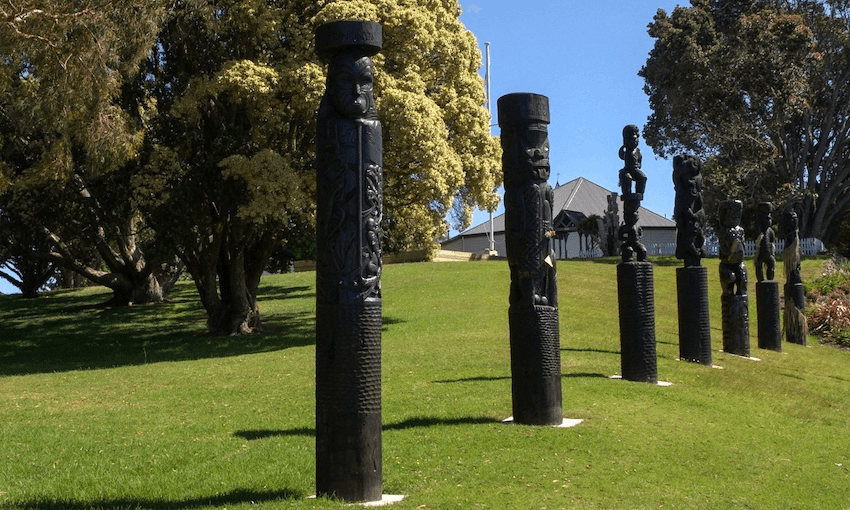This week, the National MP said the proposed compulsory history curriculum for New Zealand schools lacked ‘balance’. Historian Lydia Whiting believes his concerns hint at a deeper anxiety.
On Wednesday, speaking from the site of the battle of Ruapekapeka, prime minister Jacinda Ardern announced the rollout of the Aotearoa New Zealand histories curriculum. The curriculum posits three big ideas that centre around Māori history, the entanglements of colonisation and the nuances of power in our historical exchanges.
The response from National MP Paul Goldsmith has been predictable if not formulaic in its political opposition. Goldsmith’s criticisms are encoded, however, with deep anxieties that exist at the root of Pākehā identity. Anxieties that we have traditionally sought to soothe through a self-centred perception of a “national history”. Those Pākehā who want to see this curriculum succeed should view his response as an opportunity for reflection.
In an interview with Stuff’s Henry Cooke, Goldsmith, a former historian, argued that the draft curriculum is “lacking in balance” and that it focuses too much on “identity and identity politics” at the expense of economic histories. Goldsmith’s suggestion of the curriculum being too identity focused fails to make the important acknowledgement that history and identity are inseparable; history is the narratives we tell ourselves about ourselves.
For many historians still in the field, we can acknowledge that even the most rigidly quantitative economic and political histories are still part of a narrative. Data-driven research must also be accountable for the aspects of identity in us and in our work. The failure of white historians to reflect on this results in a continuation of a “New Zealand history” that is strictly centred around Pākehā protagonists.
If Goldsmith demonstrated this type of self-awareness, he might see that Māori historical identities and economic histories are not mutually exclusive topics. Hazel Petrie’s Chiefs of Industry, charting 19th-century Māori enterprise, offers an exemplary exploration of New Zealand’s economic history. But accepting it as such might require Goldsmith to admit to the previous dependence on Māori industry by the forebears of the Epsom constituency. Perhaps a more accurate interpretation of Goldsmith’s concern for a lack of balance and economics, then, is actually a concern for the lack of a Pākehā protagonist.
The discomfort that many Pākehā feel about our place in this land is perfectly articulated by academic Stephen Turner, who, in an essay published in 1999, wrote, “While New Zealand has grown up under the auspices of the mother country, it has not properly severed its ties, or gained cultural independence… The fantasy of a republic cannot be realised without either directly confronting or simply ignoring the negotiation of settlement with Māori, each an intractable option for Pākehā. New Zealand is therefore a land of failed separation, and, for this reason, a place in which it is hard to grow up…”
If this curriculum is an attempt at that direct confrontation, then Goldsmith’s self-assuring statements of the importance of imperial institutions in New Zealand or the “success” of Pākehā in this environment can be seen as what Turner describes as a “denial of the experience of contact”. Goldsmith claims that New Zealand’s democracy has instituted “strong traditions of freedom and law” and that at some undefined point in time “grew to attain one of the highest living standards in the world”. He is careful not to specify who was afforded this “freedom” and “high living standards”. But when used in response to a curriculum that seeks to address the relationship between past events and the inequalities of the present, Goldsmith deliberately undercuts any narrative that might threaten what he claims makes New Zealand exceptional.
In 2020, Goldsmith found himself the subject of the misguided tokenism of his fellow National MPs when he was mistaken for being of Ngāti Porou heritage. Goldsmith followed up the incident with an opinion piece entitled “Ngāti Epsom” in which identity politics are celebrated, as long as they are his own. In it he wrote, “While I have no Māori ancestry, the East Coast is thickly populated with my Goldsmith kin from the Māori side. Some friendly souls would say I’m part of the wider Ngāti Porou family.”
Goldsmith’s deployment of Ngāti Porou “connections”, coupled with a critique of what he terms as an “unbalanced” curriculum, illustrates the appropriative aspects of Pākehā identity. Literary historian Lydia Wevers has previously described this tendency as a “form of symbolic violence in which a mode of domination is presented as a form of egalitarianism”.
In an article for The Spinoff in 2019, Aroha Harris voiced her concern for a curriculum that centres Maori and Pasifika perspectives being treated as “our” national history, rather than a complex intertwinement of identities to be appreciated rather than appropriated. Goldsmith presents an important lesson for those tasked with the rollout of this curriculum itself. If this intention for a more balanced education system is not sustained with the resources it takes to ensure that key Māori concepts are disseminated appropriately, this curriculum runs the risk of bolstering a “presentation of egalitarianism” like Goldsmith’s, rather than affecting tangible change.
